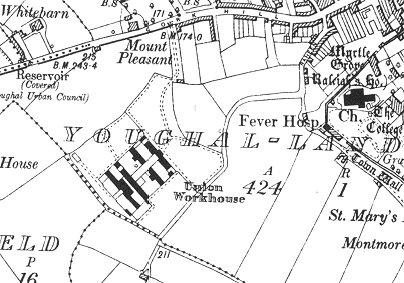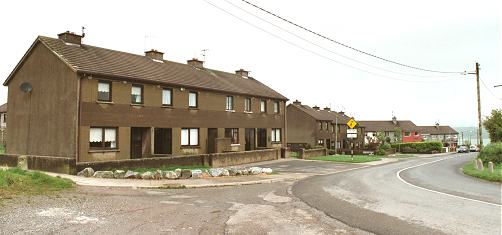Youghal, Co. Cork
Youghal was one of the new Poor Law Unions created in Ireland between 1848 and 1850. Youghal Union formally came into existence on 7th June 1850. It was created from parts of the Dungarvan, Lismore and Midleton Unions and occupied an area of 57 square miles. The population falling within the Youghal Union at the 1901 census had been 10,881. In 1905, it comprised the following electoral divisions:
Co. Cork:
Ardagh, Clonpriest, Kilcronat, Killeagh & Kilmacdonogh, Youghal Rural, Youghal Urban.
Co. Waterford:
Ardmore, Ballyheeny, Clashmore, Glenwilliam, Grallagh, Grange, Kinsalebeg, Templemichael.
The Guardians met at the workhouse on Thursdays.
The new Youghal Union workhouse was erected on a 12-acre site on an elevated site to the west of Youghal. Designed by the Poor Law Commissioners' architect George Wilkinson, it was intended to accommodate 700 inmates. Its construction cost £6,950 plus £1,375 for fittings etc. The site location and layout are shown on the 1903 map below.

Youghal workhouse site, 1903.
The layout of the workhouse was somewhat different to Wilkinson's earlier designs. There was an entrance at the north-east which probably contained the usual administrative functions such as the Guardians' board room, waiting room, porter's room and children's quarters. To the rear, two accommodation blocks were placed either side of a walled central thoroughfare which led up to a further single block, thought to house kitchens, laundry, and (later) a small convent for the nuns employed at the workhouse. A final block at the west probably contained the workhouse infirmary and idiots' wards. Unusually, there was no central spine in the building where the dining-hall and kitchen would normally have been located.
In 1895, Mallow was visited by a "commission" from the British Medical Journal investigating conditions in Irish workhouse infirmaries. Their report made a number of criticisms and recommendations. The nuns, though praised for the quality of the care they provided, lacked formal training and were overstretched so that pauper inmates needed to assist with the nursing. The provision of dayrooms was also advocated, together with indoor conveniences which should be accessible at night. The small surgery, which was also used for performing operations, was in need of alteration. Further details are available in the full report.
After the formation of the Irish Free State in 1922, the workhouse was closed, with its infirmary being adopted as the Youghal Cottage Hospital. All classes of operations were undertaken, and there was a small maternity ward for "respectable married women" — other cases were sent to Cork.
By 1903, five nuns were on the workhouse staff: the matron, three nurses, and a schoolmistress.
All the former Youghal buildings have been demolished and housing now occupies the site.

Youghal former workhouse site from the south-east, 2002
© Peter Higginbotham.
Records
Note: many repositories impose a closure period of up to 100 years for records identifying individuals. Before travelling a long distance, always check that the records you want to consult will be available.
- Cork City and County Archives, 33a Great William O'Brien Street, Blackpool, Cork. Holdings include: Board of Guardian Minute Books (1850-1924); Master's Journal (1916-1925); Outgoing Letters (1888-1900); Indoor Relief Registers (1848-1851); etc.
Bibliography
- Crossman, V (2006) Politics, Pauperism and Power in Late Nineteenth-century Ireland
- Gray, P (2009) The Making of the Irish Poor Law, 1815-43
- O'Connor, J (1995) The Workhouses of Ireland
Links
- None.
Unless otherwise indicated, this page () is copyright Peter Higginbotham. Contents may not be reproduced without permission.


